#phylum mollusca
Explore tagged Tumblr posts
Text
Some snails for your dash:
@_// @_//
\\_@
@_// @_// @_//
\\_@ @_//
@_// \\_@
@_// \\_@ @_//
//_@ \\_@
#cyberr speaks#snails#emoticons#snail#positive#happy post#snail positing#bugs#bug posting#positivity#positive post#soft#sweet#mollusk#mollusk posting#phylum mollusca
80 notes
·
View notes
Text

I put them together so they can make friends
0 notes
Text
Phylum Round 1
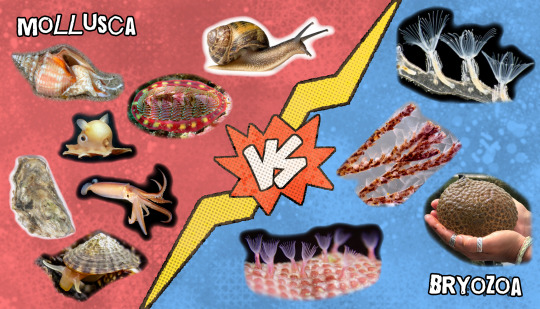
Mollusca: Snails, slugs, cephalopods, bivalves, chitons, limpets, and others. This group contains the largest invertebrates, the giant and colossal squids. They are the largest marine phylum, but many members are terrestrial. Although they are incredibly diverse in body shape, all Molluscs generally have a hard "radula" used for eating, a mantle that may secrete a hard shell, and a body mostly composed of dense muscle. These animals can be predators, herbivores, filter feeders, symbiotic, and even parasitic. This phylum exhibits remarkable diversity overall.
Bryozoa: Moss Animals. Small, frequently colonial, and often colorful, Bryozoans are found in both freshwater and marine habitats. Their crown of tentacles are used for filter feeding, similar to Entoprocta. Colonies consist of zooids living within small cup-like supports that fuse together, forming encrusting or branching structures. Individuals may take on different shapes for different roles within the colony, such as the "avicularia", which are bird-beak-shaped zooids used for defense.
#mollusca#bryozoa#animal bracket#tumblr bracket#bracket tournament#poll bracket#phylum round 1#phylum
144 notes
·
View notes
Text

18 notes
·
View notes
Text
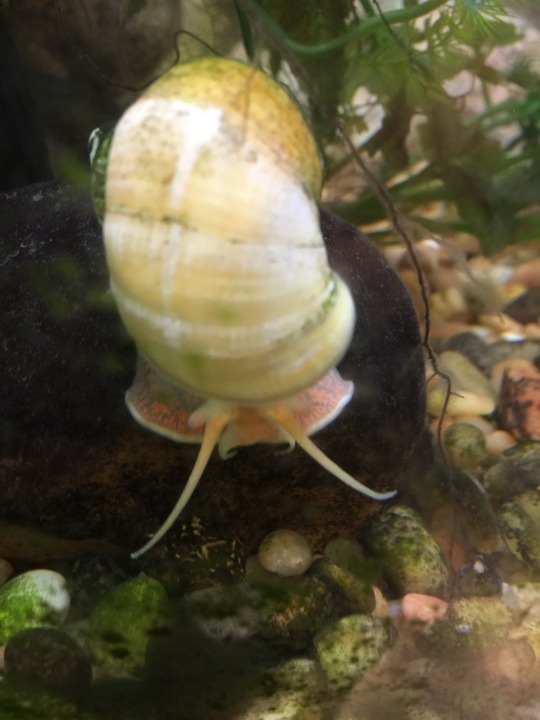
An unidentified species of freshwater snail!
1 note
·
View note
Note
it's a octopus :)
~ fish anon
That’s not a fish tho 😭😭😭😭
0 notes
Text
Round 1 Final Stats:
The top phyla have been ranked thusly, listed here from highest ranking to lowest:
🪲 Arthropoda ~ 2,002
🐠 Chordata ~ 1,780
🐌 Mollusca ~ 1,687
🪸 Cnidaria ~ 1,307
🫓 Platyhelminthes ~ 1,217
🔫 Onychophora ~ 1,180
🔬 Tardigrada ~ 1,101
🌈 Ctenophora ~ 1,013
⭐️ Echinodermata ~ 947
🪱 Annelida ~ 681
🧽 Porifera ~ 535
👥 Bryozoa ~ 331
⚪️ Placozoa ~ 328
⛱ Brachiopoda ~ 303
⚙️ Rotifera ~ 298
🍆 Priapulida ~ 216
🧲 Phoronida ~ 178
🌍 Nematoda ~ 169
🐉 Kinorhyncha ~ 169
🌰 Hemichordata ~ 169
🎉 Loricifera ~ 147
🎗 Nemertea ~ 138
❄️ Micrognathozoa ~ 124
🧪 Xenacoelomorpha ~ 123
🍴 Entoprocta ~ 111
👛 Cycliophora ~ 110
🦷 Gnathostomulida ~ 100
🏹 Chaetognatha ~ 83
🧶 Gastrotricha ~ 82
🐙🔍 Dicyemida ~ 19
🦪🔍 Orthonectida ~ 12
🐴✂️ Nematomorpha ~ -37
The top 3 phyla are Arthropoda, Chordata, and Mollusca!
This means Arthropoda, Chordata, and Mollusca will be moving on to Round 2, and broken up by Class (or some other phylogenetic equivalent).
But that’s not all!
After Round 2, we will have an extra Round 2.5, featuring every other phylum that received over 1,000 points! This will give some of the more highly ranked phyla a second chance to move on, and make Round 3 a little more interesting.
Round 2.5 will include Cnidaria, Platyhelminthes, Tardigrada, and Ctenophora.
(Unfortunately, I can’t include Onychophora as it only contains 2 families without class or order ranking, so I will have to preemptively move them forward to Round 4 ¯\_(ツ)_/¯)
To give myself enough time to queue up polls, Round 2 will begin November 1st.
See you then!
Extra Awards:
Phylum Porifera
~ had the highest percentage of likes at 50.8%
Phylum Placozoa
~ had the highest amount of neutral votes at 295
Phylum Xenacoelomorpha
~ had 0 hates
Phylum Platyhelminthes
~ had the most votes at 620
~ had the highest amount of loves at 245
~ had the highest amount of likes at 204
Phylum Gastrotricha
~ had the lowest amount of favorites at 2
~ had the lowest percentage of favorites at 0.7%
Phylum Mollusca
~ had 0 dislikes
~ had the third most reblogs at 86
Phylum Entoprocta
~ had 0 hates
Phylum Phoronida
~ had 0 hates
Phylum Orthonectida
~ had the lowest amount of likes at 20
~ had the least notes at 17
~ had the least reblogs at 6
Phylum Dicyemida
~ had the least votes at 158
~ had the lowest amount of loves at 4
~ had the lowest percentage of loves at 2.5%
~ had the highest percentage of neutral votes at 67.9%
Phylum Micrognathozoa
~ was our first single species to be ranked
~ had 0 hates
Phylum Rotifera
~ had 0 hates
Phylum Nematomorpha
~ had the highest amount of dislikes at 74
~ had the highest percentage of dislikes at 30.1%
~ had the highest percentage of hates at 11.4%
~ was the only phylum with a negative ranking
Phylum Onychophora
~ had the most notes at 310
~ had the most reblogs at 115 (though a lot of them happened after the poll closed)
Phylum Arthropoda
~ was the only phylum to get over 2,000 points
~ had the second most reblogs at 101
~ had 0 hates
Phylum Echinodermata
~ had the highest percentage of loves at 52.8%
~ was the only phylum to not receive any dislikes or hates
Phylum Chordata
~ had the highest amount of favorites at 334
~ had the highest percentage of favorites at 71.5%
~ had the lowest percentage of likes at 4.9%
~ had the lowest percentage of neutral votes at 0.6%
~ had the highest amount of hates at 37
#clearly there is a direct correlation between reblogs and votes!#chordata had the highest amount of favorites yes but Arthropoda had more votes and the positive votes add up!#and that was because more people reblogged the Arthropoda poll#anyway thank you all for voting!#hopefully I have given myself enough time and also y’all won’t lose interest by November#i run a paleoart challenge in November which will be taking up most of my time so i want to make sure I at least have all of November#queued up in advance#i’ll still be active here to answer questions and post extr propaganda though!#Statistics#extras#poll results#round 1
153 notes
·
View notes
Text
A lot of different groups evolved a similar jellyfish-like shape, from comb jellies to salps to sea butterflies! Convergent evolution is quite amazing!



These three are from completely different phyla: Ctenophora, Chordata (the same as us!) and Mollusca respectively!
Phylum #6: Echinodermata!

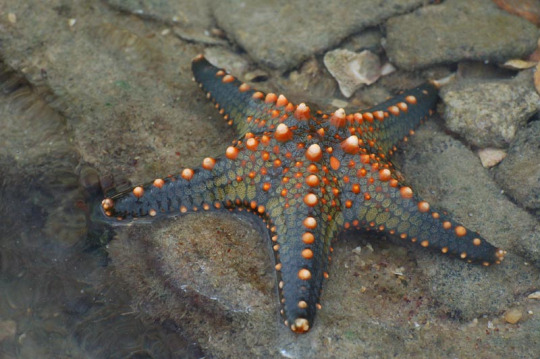
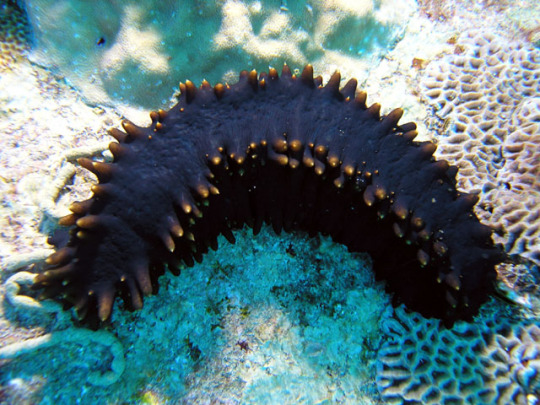
Starfish! And sea urchins, sea cucumbers and other little creatures! All of them are united by having a hard skeleton made of tiny elements called ossicles. They also have hundreds of little tube feet, powered by a entirely water pressure-based vascular system!
They're also pretty unique among bilaterians for having switched their usual bilateral symmetry for a five-way one (yes, urchins have a five-pointed star under their spikes!). Even weirder, some of them like sand dollars and sea cucumbers switched again, and got their bilateral symmetry back!
Most echinoderms are pretty familiar, but some can take on pretty unique shapes. Crinoids are filter-feeders shaped like large feathered tufts - some fixed on a stalk, while other can walk or even swim by themselves, undulating through the ocean. Until the Jurassic, reefs and rafts of crinoids floating on driftwood were extremely common, at the heart of most marine ecosystems!
Sea cucumbers are also known to exhibit quite interesting forms among echinoderms, with Pelagothuria being nearly jellyfish-like in appearance!


#forms and phyla#not a phylum#jellyfish#convergent evolution#gelatinous zooplankton#ctenophora#chordata#mollusca#comb jelly#salp#sea butterfly#marine life#marine biology
265 notes
·
View notes
Text

[ID: an illustration of a nudibranch facing to the left on a wavy blue background. It is blue with a paler face, a yellow dorsal stripe, and orange finger-like cerata appendages along its back. End.]
#00195
OPALESCENT NUDIBRANCH
Hermissenda crassicornis
PHYLUM MOLLUSCA
CLASS GASTROPODA
A sea slug inhabiting the intertidal zone and estuaries along the Pacific coast, where they hunt for tunicates and anemones. Its orange and white cerata store stinging cells from its prey, allowing it to sting would-be-predators.
121 notes
·
View notes
Note
i think a lions mane jellyfish would be cool! if youd like to continue to be cursed, id love to see what youd for a sea urchin or starfish mermaid 🧜♀️
If science of specbio intrigues you, please follow my worldbuilding blog at @worldofvonder
So mermaids are fish, straight up. Anything non-fish is not a mermaid. I do take non-fish requests! But they will either be magical creatures that are not mermaids, or they will just not be canon to my world.
There are many aquatic creatures that are not fish, and are in fact not even in the phylum chordata. "Phylum" is the first category of biology in taxonomy, which is the study of classifications.

Source: major animal phyla (video lecture!)
The kingdoms of life are: animals, plants, and fungus. Within the animal kingdom, the next step of sorting is phyla. Chordata includes vertebrates (and other animals that have a spinal cord but no bones) and it does not include jellyfish, crustaceans, octopus, and lots of other things. Interestingly, it is believed that chordata and echinoderma share a common ancestor, but they are still different phyla.
Mermaids arose from a ray finned fish, in the clade Actinopterygii. They speciated from there to become the dominant life form of the oceans. Mermaids have a process that allows groups to take on a form that is analogous to a mundane fish. If that fish evolved to eat algae, the mermaid takes on those traits while still able to eat meat. This kinship is not limited to other ray-finned fish, but encompasses many vertebrates that are commonly called "fish." This includes sharks and jawless fish like hagfish. It can include lobe-finned fish like coelacanth, but does not include tetrapods. Tetrapod creatures that resemble mermaids may be centaurs. Centaurs have a completely different origin than mermaids.
Mermaids do not have kin in other phyla. If an invertebrate resembles a human, it is through another evolutionary path than "fish that mimics humans to eat them"
Aquatic creatures and their "mermaid" (humanoid) creature counterparts
Chordata: Fish (cartiligeous, ray finned, lobe finned): Mermaids Seals and sea lions: Selkies (selkies are a subspecies of human) Whales and dolphins: selkie-mermaid hybrids: mammalmers
Arthropoda (crustaceans, arachnids, insects): fairies Mollusca: (slugs, clams, octopus): Magic mirrors Echinoderma (sea cucumbers, starfish, urchins, sanddollars): undiscovered Cnidaria (jellyfish and anemones) and Ctenophora: undiscovered
sponges, anything resembling worms, anything not mentioned: undiscovered
Many phylums have branches that superficially resemble humans despite being completely unrelated to us and each other. This phenomenon is known as anthropisation (not anthropization, which is humans changing landscapes). But don't go thinking humans are special. The same thing happens with horses.
wow there's a lot here. You're welcome lol
74 notes
·
View notes
Note
Are all cephalopod in the cephalopoda family? Genus? Kingdom? Idk which it is
Also thank you Mr squid for delivering my mail
This chart helps breakdown the animal classification order

Domain-> Kingdom-> Phylum-> Class-> Order-> Family-> Genus-> Species
[There are also (sub/super)families, (sub/super)classes, (sub/super)orders, ect.]
To get into specifics with cephalopods here is a chart breaking down the scientific classification of a hummingbird bobtail squid!
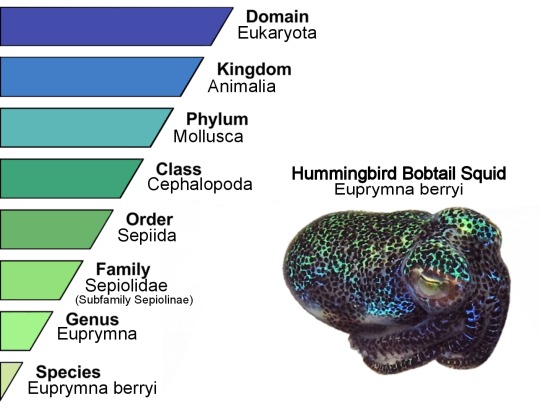
So, yes!! All cephalopods belong to the Cephalopoda class, all cephalopods also fall under the Mollusca phylum, so Cephalopods are mollusks (like snails!!)
#just getting home from vacation so ill be working on going through my ask box over the next couple days!#squid mail くコ:彡#<- he says youre welcome :3#cephalopod#taxonomy#biology#zoology#marine biology#the hummingbird bobtail squid 💙#or euprymna berryi
314 notes
·
View notes
Text
My ultimate biological allegiance is to phylum mollusca but I do love a good polychaete
13 notes
·
View notes
Text
every time I dont know the phylum of a species I go through the stages of "definitely not chordata.." "maybe mollusca?" and then I search it up and its ALWAYS ECHINODERMATA. THE STARFISH PHYLUM. shakes my fist at the sky DAMN YOU RADIAL SYMMETRY!!!!!!!
14 notes
·
View notes
Text
Phylum Round 3
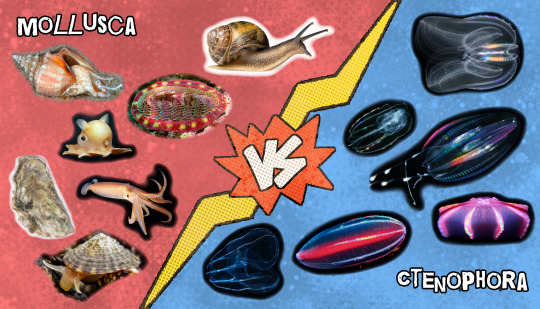
Mollusca: Snails, slugs, cephalopods, bivalves, chitons, limpets, and others. This group contains the largest invertebrates, the giant and colossal squids. They are the largest marine phylum, but many members are terrestrial. Although they are incredibly diverse in body shape, all Molluscs generally have a hard “radula” used for eating, a mantle that may secrete a hard shell, and a body mostly composed of dense muscle. These animals can be predators, herbivores, filter feeders, symbiotic, and even parasitic. This phylum exhibits remarkable diversity overall.
Ctenophora: Comb Jellies. The largest animal phylum to swim using hair-like cilia. Their cilia are arranged in rows, called combs or ctenes, down the length of their body. The cilia move in a wave-like pattern that generates colorful reflecting light shows. Almost all Ctenophores are predators of small plankton as they drift in the ocean. They inhabit a variety of marine habitats from the coastal intertidal to the open ocean.
#mollusca#ctenophora#animal bracket#tumblr bracket#bracket tournament#poll bracket#phylum round 3#phylum
83 notes
·
View notes
Note
It’s weird that the three phylums that seem relatively complex (chordata, arthropoda, and mollusca) are so unrelated. like i know they’re all bilaterian, but past that there’s not much similarity. we’re closer related to echinodermata than cephalopods! and tunicates before them! tf!? i like though that chordates evolved from a fucked up juvenile that could reproduce. tell us more about your taxonomy finds.
i feel like the model here is basically that animalia tried a bunch of really shitty blob techniques and then figured out doing things that arent shitty blobs 3 times. and not being a shitty blob is extremely valuable evolutionarily. i mean. look at this diagram

bilateria tried to be shitty worms so many times. and then a couple times it figured out not doing that and became the wonders of the rest of the animal kingdom. cnidaria i think deserves credit tho cnidaria is often. i LOVE the medusa/polyp system
36 notes
·
View notes
Text
common misconception is that dragons are closely related to chordates due to convergently evolving an internal skeleton. however, their spines do not develop from a notochord, and they actually share a most recent ancestor with the phylum mollusca
16 notes
·
View notes